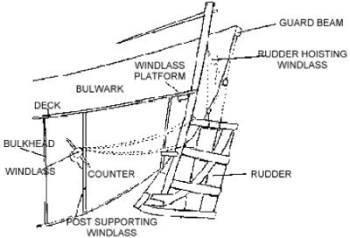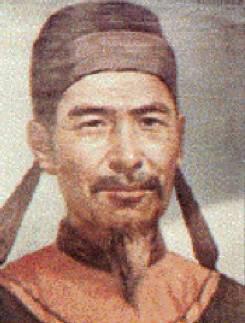1807
Ancient Chinese inventions (10 pics + text)
We know that China has a very long history - from the feudal period, which ended in 222 BC, to the present time, three emperors era - almost 4000 years of various events and research. Now it is no secret that China is the birthplace of many inventions - from spaghetti to gunpowder. In this article I will tell you about some very Chinese inventions, which have long been used in China before they were copied and used by Western civilization. Inventions are in more or less chronological order.

inline farming (the feudal period to the 6th century BC)
The Chinese began to plant crops in rows as early as the 6th century BC. This technique helps plants to grow faster and produce higher yields. Also, the beds are easier to irrigate and process, and the harvest is active. If the way to plant trees, this forest belt will be able to protect a house from the ravages of hurricane winds. Western culture to realize these features took more than 2000 years. In ancient Chinese manuscript of "Spring and Autumn Annals," a Master Lu teaches: "If the plants are growing in rows, they are developing at lightning speed, because they do not interfere with each other. It is necessary to make horizontal and vertical lines as straight as possible and guide them in the direction of the wind. " It was written in 240 BC

Compass (feudal period to the 4th century BC)
The Chinese used the first compass to indicate the direction of the mineral magnetite at least the 4th century BC. These devices were designed to predict the location and directions. Back in the 4th century BC known in China, the shaman (or whatever they are called) wrote, "is the attraction of iron magnetite, calling him." Compass, similar to what is shown in the photo, consisted of a magnetite spoons and plates, bronze plates. The first marine compasses with magnetized needles was made one and a half thousand years, in 1040, became widespread only in the mid-12th century. The phenomenon of residual magnetization, which allows these compasses work was again "invented" another 500 years, in 1600, William Gilbert (William Gilbert)

Seeder (Han dynasty, 202 BC - 220 AD)
Mechanical drill used for planting seeds at the same depth and uniform coverage of the earth. When sowing by hand the plants grow densely and irregularly, which leads to lower yields. Chinese farmers used a mechanical device seyatelnye in the second century BC. The first documented case of the use of a mechanical planter in Europe was recorded in 1566, which was confirmed by a patent in the name of Camillo Torello (Camillo Torello). Widespread mechanical seed drills only got in the middle of the nineteenth century.

Iron plow (Han dynasty, 202 BC - 220 AD)
A significant achievement zemeledeltsev ancient China considered the invention of the plow and the use of metal piles. There is evidence that such plows were used in China in the 4th century BC, but more conservative historians believe that the main distribution of such equipment received during the reign of the Han dynasty, ie 200 years later. The design used a special plow beam spacing, which allows you to adjust the distance over which the plow "dig in" to the ground. These plows were unknown in "enlightened" Europe until the 17th century AD, that is, for at least two thousand years!

Deep drilling (Han dynasty, 202 BC - 220 AD)
In the first century BC Chinese invented the method of deep drilling wells, which allowed to make holes in the ground to a depth of 1,500 meters. The principle is similar to the drill, which is used in modern drilling rigs, with towers for mounting the tool reaches a height of 60 meters. Master laid the stones with holes in the center for the direction of the tool (which is now used by guide tubes). Next, with the help of hemp ropes and bamboo structures of power are regularly overthrown and raised an iron drill, until it reaches the desired depth, where the layer of natural gas. This gas is used as fuel for the evaporation of seawater to obtain the salt. The thus obtained gas is passed on bamboo pipeline to the place of use. There is documentary evidence that the gas was used for lighting. In modern times the deep drilling of steel used for industrial purposes at the time of the Industrial Revolution in the mid-18th century.

Ship steering wheel (Han dynasty, 202 BC - 220 AD)
Chinese "sea" to achieve far surpassed his contemporaries, and have been achieved for many centuries earlier than those from Western civilization. The first documented use of the wheel to change the ship's course refers to 1190, while in China, this method of control has been known since the first century AD, that is a thousand years before! It is this age have a detailed clay models of ships depicting a suspended wheel axle (slung axial rudder), allowing to go up and steer the ship in shallow water. Later, the Chinese began to use more convenient structure of the balance wheel (freely translated terms), which the British began to use only in 1843 - 1700 years later. In the 13th century Chinese sailors used perforated steering wheel, to which Western civilization "has come" only at the beginning of the 19th century. These steering wheels have reduced resistance to reduce the water flow, and are used to control the movement of high-speed vessels (as well as torpedoes)

Harness for horses (the era of the division, the year 220-581)
Different type of harness used by humans since ancient times for use in vehicles and sleds. Lack of construction was that the horse's neck to create more pressure, which reduced its endurance and speed of movement. In the early feudal period in China (according to figures found) started using a breast yoke. During the Han Dynasty the yoke was made from soft belts and spread throughout China. In the fifth century the design has become even more efficient by moving the load for horses on the shoulders (as shown below). This design harness appeared in Europe only in the year 970 - after almost five centuries. Implementing it possible to significantly improve the performance of agriculture.

Porcelain (Sui Dynasty, 581-618 year)
Porcelain - a special type of ceramic, which is produced during high-temperature firing in a special oven. This material is sintered and becomes a sort of glass, different strength, lightness and beauty. It is known that the porcelain produced in China during the Sui Dynasty (581-618 years), but maybe it happened earlier. The technology became better during the Tang Dynasty (618-906) when used for the manufacture of porcelain white clay from the Yangtze River. In the Sung Dynasty (960-1279) the art of porcelain reached its peak. In Europe, only in 1708 the German physicist Shirnhausen (Tschirnhausen) «invented" technology porcelain, ending the monopoly of the Chinese porcelain. The photo shows a teacup in black glaze with the image of a sheet taken during the Sung Dynasty, about 1127-1279 year.

Toilet paper (Song Dynasty, 960-1279 years)
It is known that paper was invented in China, and the first application of its hygienic purposes dates back to the Sui Dynasty in 589. In 851, the Arab traveler wrote with amazement that the Chinese use paper instead of water to cleanse the body. In the early 14th century it produces about 700,000 sheets of paper into packs of 1000 to 10000 pieces. For comparison - in colonial America in the early 18th century (400 years) for the necessities of hygiene widely used corn leaves Commercial toilet paper appeared only in the mid-19th century, one of the producers specified that it was "almost without chips" (tough!). Interestingly, the ancient Romans used for such purposes wand with a sponge on one end

Printing with movable type (Song Dynasty, 960-1279 years)
The first printed book was created in about 868 year. Through 100 years of master Bi Sheng (990-1051, pictured above). Using clay fired removable letters he invented the technology of removable letters and developed the basic intricacies of printing using them. The technology has been continuously improved, which took nearly 300 years. In contrast - the Gutenberg Bible, which is considered Europe's first printed book with removable letters, was made in the mid-15th century. It is noteworthy that the Chinese do not use metal letters before the end of the 15th century.
Apparently, all invented before the last 100 years, we can safely attribute to Chinese, err difficult. It's just a fantastic diverse nation, which deals not only with cheap jeans and unreliable cars, but also invented (or at least used to) many useful and even essential things. What do you think?
p-i-f.livejournal.com

inline farming (the feudal period to the 6th century BC)
The Chinese began to plant crops in rows as early as the 6th century BC. This technique helps plants to grow faster and produce higher yields. Also, the beds are easier to irrigate and process, and the harvest is active. If the way to plant trees, this forest belt will be able to protect a house from the ravages of hurricane winds. Western culture to realize these features took more than 2000 years. In ancient Chinese manuscript of "Spring and Autumn Annals," a Master Lu teaches: "If the plants are growing in rows, they are developing at lightning speed, because they do not interfere with each other. It is necessary to make horizontal and vertical lines as straight as possible and guide them in the direction of the wind. " It was written in 240 BC

Compass (feudal period to the 4th century BC)
The Chinese used the first compass to indicate the direction of the mineral magnetite at least the 4th century BC. These devices were designed to predict the location and directions. Back in the 4th century BC known in China, the shaman (or whatever they are called) wrote, "is the attraction of iron magnetite, calling him." Compass, similar to what is shown in the photo, consisted of a magnetite spoons and plates, bronze plates. The first marine compasses with magnetized needles was made one and a half thousand years, in 1040, became widespread only in the mid-12th century. The phenomenon of residual magnetization, which allows these compasses work was again "invented" another 500 years, in 1600, William Gilbert (William Gilbert)

Seeder (Han dynasty, 202 BC - 220 AD)
Mechanical drill used for planting seeds at the same depth and uniform coverage of the earth. When sowing by hand the plants grow densely and irregularly, which leads to lower yields. Chinese farmers used a mechanical device seyatelnye in the second century BC. The first documented case of the use of a mechanical planter in Europe was recorded in 1566, which was confirmed by a patent in the name of Camillo Torello (Camillo Torello). Widespread mechanical seed drills only got in the middle of the nineteenth century.

Iron plow (Han dynasty, 202 BC - 220 AD)
A significant achievement zemeledeltsev ancient China considered the invention of the plow and the use of metal piles. There is evidence that such plows were used in China in the 4th century BC, but more conservative historians believe that the main distribution of such equipment received during the reign of the Han dynasty, ie 200 years later. The design used a special plow beam spacing, which allows you to adjust the distance over which the plow "dig in" to the ground. These plows were unknown in "enlightened" Europe until the 17th century AD, that is, for at least two thousand years!

Deep drilling (Han dynasty, 202 BC - 220 AD)
In the first century BC Chinese invented the method of deep drilling wells, which allowed to make holes in the ground to a depth of 1,500 meters. The principle is similar to the drill, which is used in modern drilling rigs, with towers for mounting the tool reaches a height of 60 meters. Master laid the stones with holes in the center for the direction of the tool (which is now used by guide tubes). Next, with the help of hemp ropes and bamboo structures of power are regularly overthrown and raised an iron drill, until it reaches the desired depth, where the layer of natural gas. This gas is used as fuel for the evaporation of seawater to obtain the salt. The thus obtained gas is passed on bamboo pipeline to the place of use. There is documentary evidence that the gas was used for lighting. In modern times the deep drilling of steel used for industrial purposes at the time of the Industrial Revolution in the mid-18th century.

Ship steering wheel (Han dynasty, 202 BC - 220 AD)
Chinese "sea" to achieve far surpassed his contemporaries, and have been achieved for many centuries earlier than those from Western civilization. The first documented use of the wheel to change the ship's course refers to 1190, while in China, this method of control has been known since the first century AD, that is a thousand years before! It is this age have a detailed clay models of ships depicting a suspended wheel axle (slung axial rudder), allowing to go up and steer the ship in shallow water. Later, the Chinese began to use more convenient structure of the balance wheel (freely translated terms), which the British began to use only in 1843 - 1700 years later. In the 13th century Chinese sailors used perforated steering wheel, to which Western civilization "has come" only at the beginning of the 19th century. These steering wheels have reduced resistance to reduce the water flow, and are used to control the movement of high-speed vessels (as well as torpedoes)

Harness for horses (the era of the division, the year 220-581)
Different type of harness used by humans since ancient times for use in vehicles and sleds. Lack of construction was that the horse's neck to create more pressure, which reduced its endurance and speed of movement. In the early feudal period in China (according to figures found) started using a breast yoke. During the Han Dynasty the yoke was made from soft belts and spread throughout China. In the fifth century the design has become even more efficient by moving the load for horses on the shoulders (as shown below). This design harness appeared in Europe only in the year 970 - after almost five centuries. Implementing it possible to significantly improve the performance of agriculture.

Porcelain (Sui Dynasty, 581-618 year)
Porcelain - a special type of ceramic, which is produced during high-temperature firing in a special oven. This material is sintered and becomes a sort of glass, different strength, lightness and beauty. It is known that the porcelain produced in China during the Sui Dynasty (581-618 years), but maybe it happened earlier. The technology became better during the Tang Dynasty (618-906) when used for the manufacture of porcelain white clay from the Yangtze River. In the Sung Dynasty (960-1279) the art of porcelain reached its peak. In Europe, only in 1708 the German physicist Shirnhausen (Tschirnhausen) «invented" technology porcelain, ending the monopoly of the Chinese porcelain. The photo shows a teacup in black glaze with the image of a sheet taken during the Sung Dynasty, about 1127-1279 year.

Toilet paper (Song Dynasty, 960-1279 years)
It is known that paper was invented in China, and the first application of its hygienic purposes dates back to the Sui Dynasty in 589. In 851, the Arab traveler wrote with amazement that the Chinese use paper instead of water to cleanse the body. In the early 14th century it produces about 700,000 sheets of paper into packs of 1000 to 10000 pieces. For comparison - in colonial America in the early 18th century (400 years) for the necessities of hygiene widely used corn leaves Commercial toilet paper appeared only in the mid-19th century, one of the producers specified that it was "almost without chips" (tough!). Interestingly, the ancient Romans used for such purposes wand with a sponge on one end

Printing with movable type (Song Dynasty, 960-1279 years)
The first printed book was created in about 868 year. Through 100 years of master Bi Sheng (990-1051, pictured above). Using clay fired removable letters he invented the technology of removable letters and developed the basic intricacies of printing using them. The technology has been continuously improved, which took nearly 300 years. In contrast - the Gutenberg Bible, which is considered Europe's first printed book with removable letters, was made in the mid-15th century. It is noteworthy that the Chinese do not use metal letters before the end of the 15th century.
Apparently, all invented before the last 100 years, we can safely attribute to Chinese, err difficult. It's just a fantastic diverse nation, which deals not only with cheap jeans and unreliable cars, but also invented (or at least used to) many useful and even essential things. What do you think?
p-i-f.livejournal.com






















